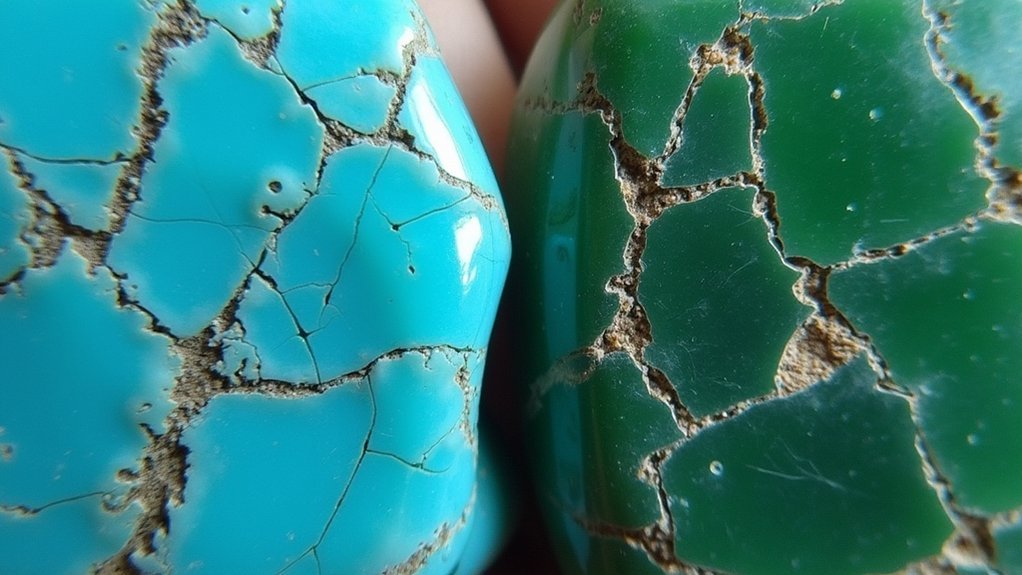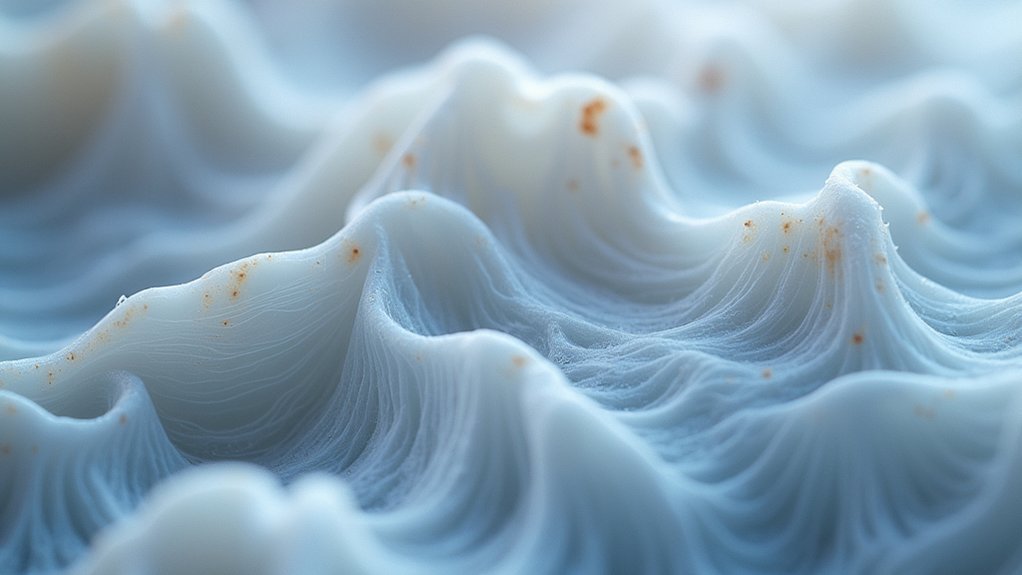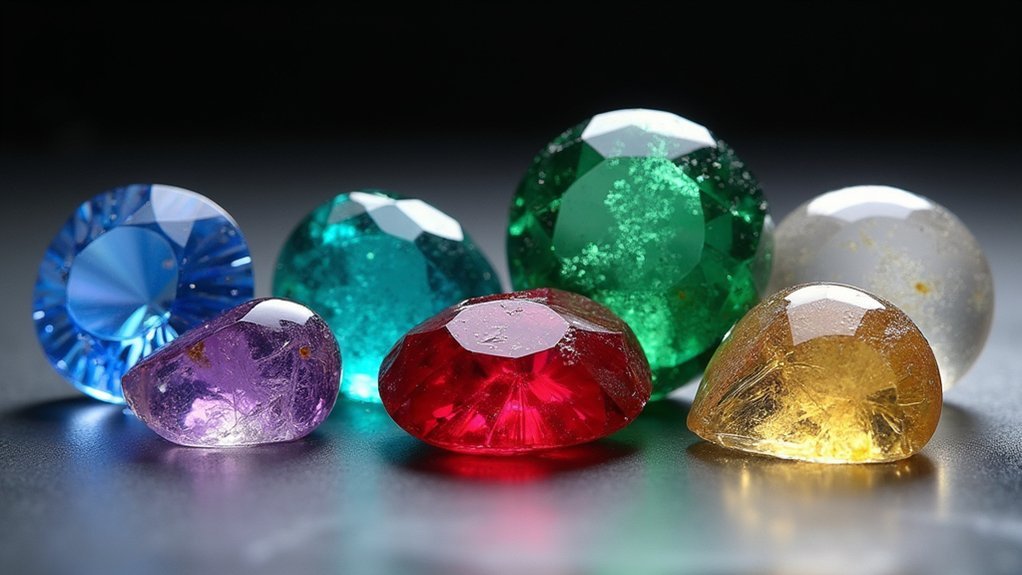Gemstones reveal their identity through seven distinctive fracture patterns: conchoidal (curved surfaces in quartz and obsidian), splintery (wood-like breaks in fibrous minerals), hackly (jagged edges in copper-bearing stones), uneven (rough surfaces in turquoise and jade), granular (equidimensional fragments in lapis lazuli), subconchoidal (smooth curves in chalcedony), and diamond fractures (distinct from cleavage planes). You’ll find these patterns essential for authentication and identification when examining specimens under magnification. These breakage characteristics disclose deeper insights into each gemstone’s unique structure.
Conchoidal Fractures in Quartz and Obsidian

When examining gemstone fracture patterns, you’ll find that conchoidal fractures stand out for their distinctive smooth, curved surfaces that resemble seashell interiors. Quartz and obsidian are prime examples of this phenomenon.
In quartz, these conchoidal fracture surfaces create exceptionally sharp edges that made it valuable for ancient tool-making. The evenly distributed atomic bonds allow quartz to break irregularly without following natural weakness planes.
Obsidian displays even more pronounced conchoidal fractures with highly lustrous surfaces. This volcanic glass breaks with remarkable sharpness and an attractive appearance that enhances its appeal.
As a gemologist, you’ll recognize these unique fracture patterns to differentiate quartz and obsidian from minerals with different breakage characteristics. The smooth, curved breaks serve as reliable identification markers when examining these common gemstones.
Splintery Fracture Patterns in Fibrous Gemstones
You’ll immediately notice hematite’s distinctive splintery break when examining a freshly fractured surface.
Fibrous minerals reveal their unique textures through these elongated, sharp-edged patterns that resemble wood splinters under magnification.
These characteristic fractures aren’t just visually interesting—they’re essential identifiers that help you distinguish fibrous gemstones from those with conchoidal or uneven breakage patterns.
Examining Hematite’s Splintery Break
The distinct splintery fracture pattern of hematite presents a fascinating example of how mineral composition influences breakage characteristics.
When you examine hematite samples, you’ll notice sharp, jagged edges reminiscent of broken wood—a direct result of its iron oxide crystal structure. These splintery fractures create linear markings that serve as valuable identification markers when you’re evaluating physical properties of unknown specimens.
- The metallic luster on the fracture surface makes hematite immediately distinguishable from similar-colored minerals.
- Fracture patterns reveal internal atomic arrangements that aren’t visible in the mineral’s external appearance.
- You can differentiate hematite from minerals with conchoidal fractures by observing its wood-like splinters.
- The fibrous nature of these breaks indicates how forces travel through the mineral’s crystalline network.
Fibrous Minerals’ Unique Textures
Fibrous minerals create some of the most distinctive and identifiable fracture patterns in the gemstone world, revealing their internal structure through characteristic splintery breaks.
When you examine these gems, you’ll notice elongated, pointed edges resembling wood splinters rather than the smooth surfaces found in other minerals. This unique texture occurs because fibrous minerals like asbestos and certain tourmaline varieties break along their fiber orientation rather than across it.
In gemology, recognizing these splintery fractures helps you differentiate between similar-looking specimens. Nephrite jade exemplifies this property, with its splintery fracture contributing to its distinctive appearance in jewelry.
The identification of these fracture patterns isn’t just academically interesting—it provides vital insights into a gemstone’s structural integrity and determines its suitability for various applications and cutting techniques.
Hackly Fractures in Native Metals and Copper-Bearing Stones

You’ll notice hackly fractures in native metals by their sharp, jagged edges and irregular surfaces that reflect light with a distinctive metallic luster.
When examining copper-bearing stones like malachite or azurite, these uneven breakage patterns occur where the mineral structure fails under stress, creating characteristic rough surfaces.
These fracture patterns serve as valuable identification markers, helping you distinguish native copper from similar-looking minerals that typically display smoother, conchoidal fractures.
Hackly Fracture Characteristics
Jagged edges and irregular surfaces define hackly fractures, a distinctive pattern found primarily in native metals like copper and silver, as well as various copper-bearing minerals.
You’ll notice these fractures don’t follow distinct cleavage planes due to the inherent brittleness of the material. When examining native copper specimens, look for the rough, splintered texture that resembles broken wood—this is a telltale sign of its native state.
- The irregular surface creates unique light reflection patterns, enhancing the aesthetic appeal of copper-bearing stones like malachite.
- Sharp, jagged edges help distinguish hackly fractures from other breakage patterns.
- These fractures indicate natural, unrefined metal forms rather than processed specimens.
- The wood-like, fibrous appearance is particularly characteristic in native copper samples.
Identifying Copper Inclusions
Copper inclusions in gemstones create distinctive hackly fracture patterns that serve as key identifiers for collectors and gemologists alike.
When examining a specimen under magnification, you’ll notice sharp, jagged edges with irregular surfaces that differ dramatically from smoother fracture patterns found in other minerals.
Unlike gas inclusions or calcite inclusions which often create rounded or rhombohedral patterns, copper creates uniquely metallic, uneven breakage points due to its distinctive bonding structure.
You’ll find these hackly fractures particularly evident in stones like malachite and azurite when they contain native copper. The fracture’s texture reveals both the stone’s authenticity and potentially increases its value.
When evaluating a gemstone’s origin, these copper-induced patterns provide conclusive evidence of natural formation processes and can help you distinguish genuine specimens from imitations.
Native Metal Patterns
Native metals tell their own unique story through characteristic hackly fractures that distinguish them from other minerals in the gemological world. When you’re examining gold, silver, or copper specimens, you’ll notice these rough and irregular breaks that resemble torn metal rather than clean splits.
This types of fracture is often seen in copper-bearing stones like malachite and azurite as well, offering valuable identification clues during your examination.
- These jagged patterns directly reflect the metal’s ductile and malleable nature
- Inclusions might create distinctive fracture interfaces where native metals meet host stones
- The hackly appearance helps you differentiate true native metals from similar-looking minerals
- When polished, these fractures create unique reflective properties that enhance visual appeal
Uneven Fractures in Turquoise and Jade

Despite their popularity in jewelry and ornamental carvings, turquoise and jade reveal their complex mineral composition through distinctive uneven fracture patterns.
When examining these gemstones, you’ll notice they don’t break along smooth planes like solid crystal materials. Instead, turquoise exhibits rough, non-uniform surfaces that reflect its fibrous microcrystalline structure.
Jade similarly displays irregular breakage patterns that align with its dense, interlocking crystal form. You’ll often observe a powdery or crumbly appearance where fractures occur, with inclusions along the break points creating unique characteristics in each specimen.
Jade’s irregular fracture reveals its interlocking crystal structure, with distinctive powdery breaks showcasing inclusions unique to each specimen.
These uneven fracture patterns serve as important identification markers when you’re authenticating stones—natural specimens typically show more irregularities than their synthetic counterparts.
Granular Fracture Characteristics in Lapis Lazuli
When examining the fracture patterns in lapis lazuli, you’ll immediately notice its distinctive granular structure that breaks into small, equidimensional fragments rather than along clean planes.
This granular fracture reflects the stone’s metamorphic origin, forming under intense pressure and temperature conditions that influence its internal structure.
- Under magnification, you’ll see individual crystals arranged in a complex matrix that contributes to the stone’s rough, uneven surfaces.
- Golden pyrite inclusions create a speckled effect within the fracture pattern, enhancing its star-like appearance.
- The granularity markedly affects how light interacts with the stone, intensifying its deep blue coloration.
- Unlike gemstones with perfect cleavage, lapis lazuli’s rough fracture pattern serves as a key identification feature for gemologists.
Subconchoidal Patterns in Chalcedony Varieties

Moving from lapis lazuli’s granular structure, we encounter an entirely different fracture behavior in chalcedony varieties. Unlike minerals with distinct cleavage planes, chalcedony breaks with subconchoidal fractures—smooth, curved surfaces that aren’t as pronounced as true conchoidal patterns.
You’ll notice these fractures contribute greatly to chalcedony’s characteristic appearance, giving it a dull to waxy luster that distinguishes it from other gemstones.
When examining varieties like agate, jasper, and onyx, you’ll observe how their fracture surfaces often display subtle color banding or translucency, enhancing their visual appeal.
This subconchoidal fracture pattern also indicates chalcedony’s inherent toughness. Unlike more brittle minerals, chalcedony withstands stress without shattering into sharp fragments, making it both durable and identifiable through these distinctive breaking patterns.
Distinguishing Fractures From Cleavage Planes in Diamonds
Unlike chalcedony’s subconchoidal patterns, diamonds present a more complex identification challenge through their distinctive fracture behaviors.
You’ll notice diamonds exhibit conchoidal fracture patterns with smooth, curved surfaces that create sharp edges, distinguishing them from the predictable cleavage planes found in other minerals.
- Examine the bruted girdle areas where natural fracture patterns appear, unlike the uniform appearance of cleavage planes
- Look for elongated prismatic crystals and internal reflections that characterize diamond fractures
- Observe fracture surfaces under magnification to reveal the characteristic glassy luster absent in cleaved faces
- Note that while diamonds have minimal cleavage along specific crystallographic axes, fractures are more randomly distributed
These fracture characteristics provide essential visual cues that you can use to authenticate diamonds from similar-appearing gemstones when standard testing equipment isn’t available.
Frequently Asked Questions
How to Identify Inclusions in Gemstones?
You can identify gemstone inclusions using high magnification and proper lighting techniques. Observe their shapes, sizes, and orientations through microscopes. Look for telltale patterns like fluid-filled cavities or mineral crystals inside the stone.
What Is a Fracture in Mineral Identification?
A fracture is the way a mineral breaks apart when it doesn’t follow cleavage planes. You’ll notice irregular surfaces rather than smooth planes. It’s a key characteristic you’ll use when identifying minerals.
How Do I Identify Different Types of Gemstones?
You’ll identify gemstones by examining their physical properties: hardness, luster, color, cleavage and fracture patterns. Use a loupe to observe crystal structure and test specific gravity with specialized equipment when needed.
What Gemstones Have a Conchoidal Fracture?
You’ll find conchoidal fractures in quartz, obsidian, and chalcedony. These gemstones break with smooth, curved surfaces resembling seashells. This fracture pattern occurs in hard, brittle materials with strong atomic bonds.
In Summary
You’ll find that mastering these seven fracture patterns gives you a significant advantage in gemstone identification. When you’re examining an unknown specimen, look for these distinctive break patterns first, as they’re reliable indicators of a stone’s identity. Remember, fractures differ from cleavage planes – they’re irregular breaks rather than clean splits along crystal structures. With practice, you’ll recognize these patterns instantly, even in rough specimens.





Leave a Reply